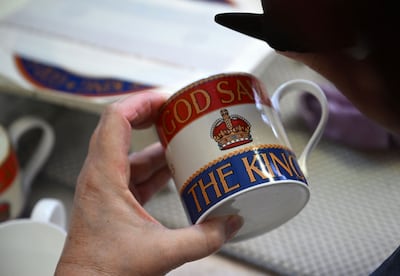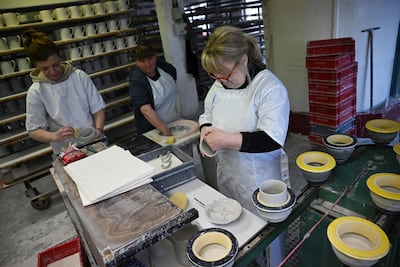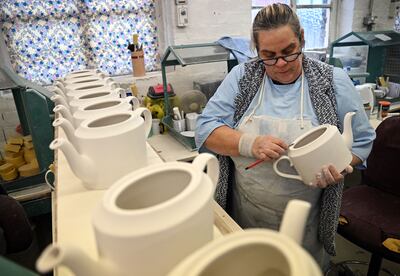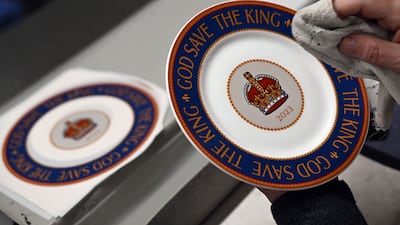A collection of hand-finished bone China has gone on sale commemorating the upcoming coronation of King Charles III and Queen Consort Camilla.
The range, made using centuries-old manufacturing processes in the heart of the Potteries, an area around Stoke-on-Trent, marks the May 6 ceremony at Westminster Abbey.
The bespoke design incorporates the royal coat of arms and a garland of laurel leaves symbolising peace.
Also featured is a decorative border of oak leaves signifying strength and longevity alongside the emblems of the four nations of the UK — the thistle, rose, shamrock and daffodil — while an entwined ribbon symbolises the partnership of the king and queen consort.
The range, from the Royal Collection Trust charity, features Charles's cypher, which is stamped in gold foil, designed by The College of Arms and consists of initials from his name and title, rex, which is Latin for king.
Ian Grant, the trust's head of product development and buying, said the process of designing and manufacturing thousands of pieces brought enormous pride to the staff working to produce the range.
The trust, part of the royal household, has been making commemorative china for 30 years.
But Mr Grant said: “This is probably the most momentous occasion we've developed a product for.”
Mr Grant, who started in the industry as an apprentice at Wedgwood in 1984, said designers and artisans needed to create a line of desirable products “very quickly” after the coronation date was announced.
The exact manufacturing location is kept under wraps, but workers there, some of whom started in the pottery-making industry as teenagers and are now in their 60s, spoke of their delight at being involved in marking such a historic event.
Mr Grant said each stage requires “years of training”, building to an “amazing process” which gives value to the Made in England stamp each item has applied on its base.
The china is fired in a biscuit kiln at 1,238°C for 11 hours, baking the pottery to such an extent that, when emptied at 4am, it will have shrunk by 15 per cent — a percentage indicating a fine quality bone china.
Pieces are then put in electric vibrating machines filled with small composite cubes of wood and pottery which act to “polish” the item without damaging it, allowing it to be glazed, and fired again at 1,080C.
The items are then decorated with a hand-applied silkscreen litho print.
In their still unfinished state, the colours on the decorated items — featuring paint containing liquid gold — are mismatched.
But once fired for a third and final time at 810°C, the heat and chemical processes turn the browns into golds and the green becomes a deep and vivid royal blue.
Even the boxes into which the pieces are packed are handmade by another Stoke-on-Trent firm, where an experienced team can make 200 packages an hour.
Mr Grant said: “Our guests and visitors to the sites at Buckingham Palace, Windsor Castle and the Palace of Holyroodhouse always look for something a little bit special when they visit us.
“So we wanted to make sure that this product met the expectations of our visitors but also truly and properly reflected the occasion.”
The range comprises a coffee mug priced at £30, pillbox at £40, tankard at £50, an eight-inch dessert plate also at £50, and a tea cup and saucer at £75.
There are also several limited edition lines which will be hand-numbered, produced in smaller runs ranging from 150 to 1,000 and be “a little bit more special”, Mr Grant said.
Profits go to the trust for the care and conservation of the Royal Collection.
EA Sports FC 26
Publisher: EA Sports
Consoles: PC, PlayStation 4/5, Xbox Series X/S
Rating: 3/5
More from our Neighbourhood series:
Who has lived at The Bishops Avenue?
- George Sainsbury of the supermarket dynasty, sugar magnate William Park Lyle and actress Dame Gracie Fields were residents in the 1930s when the street was only known as ‘Millionaires’ Row’.
- Then came the international super rich, including the last king of Greece, Constantine II, the Sultan of Brunei and Indian steel magnate Lakshmi Mittal who was at one point ranked the third richest person in the world.
- Turkish tycoon Halis Torprak sold his mansion for £50m in 2008 after spending just two days there. The House of Saud sold 10 properties on the road in 2013 for almost £80m.
- Other residents have included Iraqi businessman Nemir Kirdar, singer Ariana Grande, holiday camp impresario Sir Billy Butlin, businessman Asil Nadir, Paul McCartney’s former wife Heather Mills.
Hunting park to luxury living
- Land was originally the Bishop of London's hunting park, hence the name
- The road was laid out in the mid 19th Century, meandering through woodland and farmland
- Its earliest houses at the turn of the 20th Century were substantial detached properties with extensive grounds
DUNE%3A%20PART%20TWO
%3Cp%3E%3Cstrong%3EDirector%3A%3C%2Fstrong%3E%20Denis%20Villeneuve%3C%2Fp%3E%0A%3Cp%3E%3Cstrong%3EStarring%3A%3C%2Fstrong%3E%20Timothee%20Chamalet%2C%20Zendaya%2C%20Austin%20Butler%3C%2Fp%3E%0A%3Cp%3E%3Cstrong%3ERating%3A%3C%2Fstrong%3E%205%2F5%3C%2Fp%3E%0A
THE SPECS
Engine: 6.75-litre twin-turbocharged V12 petrol engine
Power: 420kW
Torque: 780Nm
Transmission: 8-speed automatic
Price: From Dh1,350,000
On sale: Available for preorder now
Did you know?
Brunch has been around, is some form or another, for more than a century. The word was first mentioned in print in an 1895 edition of Hunter’s Weekly, after making the rounds among university students in Britain. The article, entitled Brunch: A Plea, argued the case for a later, more sociable weekend meal. “By eliminating the need to get up early on Sunday, brunch would make life brighter for Saturday night carousers. It would promote human happiness in other ways as well,” the piece read. “It is talk-compelling. It puts you in a good temper, it makes you satisfied with yourself and your fellow beings, it sweeps away the worries and cobwebs of the week.” More than 100 years later, author Guy Beringer’s words still ring true, especially in the UAE, where brunches are often used to mark special, sociable occasions.
SCHEDULE
Saturday, April 20: 11am to 7pm - Abu Dhabi World Jiu-Jitsu Festival and Para jiu-jitsu.
Sunday, April 21: 11am to 6pm - Abu Dhabi World Youth (female) Jiu-Jitsu Championship.
Monday, April 22: 11am to 6pm - Abu Dhabi World Youth (male) Jiu-Jitsu Championship.
Tuesday, April 23: 11am-6pm Abu Dhabi World Masters Jiu-Jitsu Championship.
Wednesday, April 24: 11am-6pm Abu Dhabi World Professional Jiu-Jitsu Championship.
Thursday, April 25: 11am-5pm Abu Dhabi World Professional Jiu-Jitsu Championship.
Friday, April 26: 3pm to 6pm Finals of the Abu Dhabi World Professional Jiu-Jitsu Championship.
Saturday, April 27: 4pm and 8pm awards ceremony.
INDIA SQUAD
Virat Kohli (capt), Rohit Sharma, Shikhar Dhawan, KL Rahul, Vijay Shankar, MS Dhoni (wk), Kedar Jadhav, Dinesh Karthik, Yuzvendra Chahal, Kuldeep Yadav, Bhuvneshwar Kumar, Jasprit Bumrah, Hardik Pandya, Ravindra Jadeja, Mohammed Shami
Karwaan
Producer: Ronnie Screwvala
Director: Akarsh Khurana
Starring: Irrfan Khan, Dulquer Salmaan, Mithila Palkar
Rating: 4/5
DEADPOOL & WOLVERINE
Starring: Ryan Reynolds, Hugh Jackman, Emma Corrin
Director: Shawn Levy
Rating: 3/5
The President's Cake
Director: Hasan Hadi
Starring: Baneen Ahmad Nayyef, Waheed Thabet Khreibat, Sajad Mohamad Qasem
Rating: 4/5
The specs: 2018 Jaguar E-Pace First Edition
Price, base / as tested: Dh186,480 / Dh252,735
Engine: 2.0-litre four-cylinder
Power: 246hp @ 5,500rpm
Torque: 365Nm @ 1,200rpm
Transmission: Nine-speed automatic
Fuel consumption, combined: 7.7L / 100km
Company profile
Name: Thndr
Started: October 2020
Founders: Ahmad Hammouda and Seif Amr
Based: Cairo, Egypt
Sector: FinTech
Initial investment: pre-seed of $800,000
Funding stage: series A; $20 million
Investors: Tiger Global, Beco Capital, Prosus Ventures, Y Combinator, Global Ventures, Abdul Latif Jameel, Endure Capital, 4DX Ventures, Plus VC, Rabacap and MSA Capital
We Weren’t Supposed to Survive But We Did
We weren’t supposed to survive but we did.
We weren’t supposed to remember but we did.
We weren’t supposed to write but we did.
We weren’t supposed to fight but we did.
We weren’t supposed to organise but we did.
We weren’t supposed to rap but we did.
We weren’t supposed to find allies but we did.
We weren’t supposed to grow communities but we did.
We weren’t supposed to return but WE ARE.
Amira Sakalla
The specs
- Engine: 3.9-litre twin-turbo V8
- Power: 640hp
- Torque: 760nm
- On sale: 2026
- Price: Not announced yet
HOW DO SIM CARD SCAMS WORK?
Sim swap frauds are a form of identity theft.
They involve criminals conning mobile phone operators into issuing them with replacement Sim cards, often by claiming their phone has been lost or stolen
They use the victim's personal details - obtained through criminal methods - to convince such companies of their identity.
The criminal can then access any online service that requires security codes to be sent to a user's mobile phone, such as banking services.





